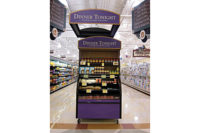LED's in retailers’ milk display cases can help to preserve milk's flavor
LED lights in retailers’ milk display cases do more than just reduce energy bills. They also help milk taste better, according to researchers at Virginia Tech, Blacksburg.
The exposure to certain light changes the flavor profile of milk. Milk fresh from the dairy should taste sweet and rich but when people describe milk that was exposed to conventional fluorescent lights, they used words like “cardboard,” “stale” and “painty.”
Researchers found that while the new LED lights reduce those negative profiles, there is still work to be done in packaging.
“We want to help figure out ways to return to the fresh taste of milk that our grandparents experienced when it came straight from the dairy,” said Susan Duncan, a professor of food science and technology in the Virginia Tech College of Agriculture and Life Sciences. She published her findings in the Journal of Dairy Science.
Riboflavin, one of the nutrients in milk, oxidizes when exposed to fluorescent lights. This reaction not only causes the taste to change, but can also reduce the nutritional content of milk.
Duncan’s tests show that when milk is stored in the traditional translucent plastic jugs, these reactions can take place in as little as two hours. Opaque milk packaging protects riboflavin and other nutrients from lighting.
Duncan conducted a series of tests at the Virginia Tech Sensory Evaluation Laboratory that showed the new LED lights leave milk with a more satisfactory taste that consumers prefer over milk that has been exposed to fluorescent lights.
Funding for this project came from check-off money from the dairy farmers through the National Dairy Council, as well as support from the USDA Hatch program and the Virginia Agricultural Experiment Station at Virginia Tech.
Duncan said more work still needs to be done on packaging to protect flavor profiles even further. If the traditional HDPE translucent jugs are used, milk is more likely to undergo oxidation and have its flavor changed. But her tests shows that when light-blocking pigments in HDPE or plastic PET containers were used, the flavor wasn’t changed as dramatically and consumers thought the milk tasted fresh.
Though improved packaging costs more than the traditional jugs, Duncan said the cost is worth it to maintain the best flavor of milk.
— Contributed by Virginia Tech
Looking for a reprint of this article?
From high-res PDFs to custom plaques, order your copy today!







